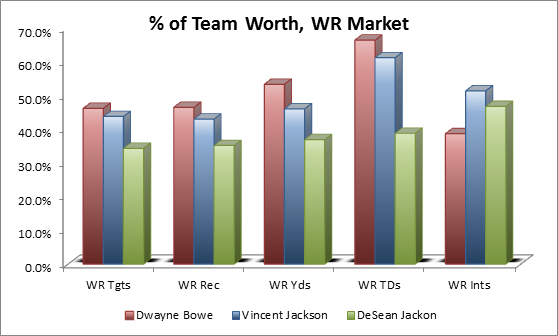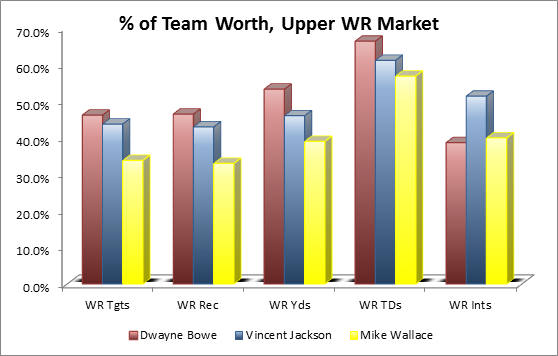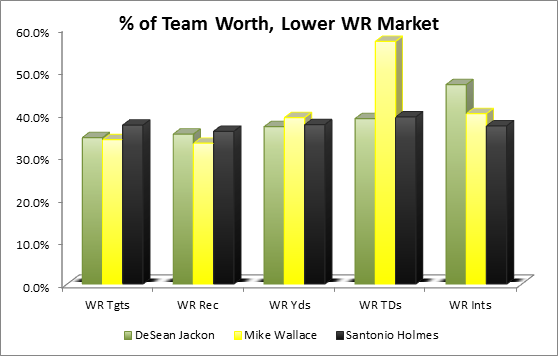One of the things that I have always liked to do is to take a stab at valuing players’ contracts in the context of the market. While I think this is a poor season overall for free agents there are a few positions that have a healthy group of above average players and one is the wide receiver position. To start things off with some free agent valuations that maybe I’ll get to over the next few weeks we will look at Dwayne Bowe of the Kansas City Chiefs. Bowe was a franchise player last year and is now rumored to be in negotiations to stay in Kansas City.
Basic Stats
I usually like to start off by looking at the past three years for a player and just examining their basic output. For a WR that is going to be games played, receptions, catch rate, yards, average, and touchdowns. Here we have Bowes stats:
| G | Rec | Yds | Avg | TD | Catch Rate |
2010 | 16 | 72 | 1162 | 16.1 | 15 | 57.6% |
2011 | 16 | 81 | 1159 | 14.3 | 5 | 62.3% |
2012 | 13 | 59 | 801 | 13.6 | 3 | 55.1% |
| Average | 15 | 70.7 | 1040.7 | 14.73 | 7.7 | 58.3% |
Obviously there are a few warning signs here. Bowe’s YPR has fallen every year and his last two years are actually below his three year average. His TD totals are completely inflated by the 2010 season. Considering the typical volatility at the position these numbers would make me a little nervous about breaking the bank for this player, so I want to look a little deeper.
Comparative Performance
Football is a unique game in that its really the only sport where 11 moving parts are responsible for the end result. Of all the positions in the NFL my own feeling is that the Wide Receiver is the most dependent of all. First they need a QB to get the ball to them on target. For that to happen the QB needs protection from his line to throw. Having a running game to draw a safety off playaction is a tremendous benefit for a receiver. If things aren’t right around him he is not going to perform. So I want to compare the performance of the player to those on the team around him. Here is Bowe’s contribution to the offense over the last three seasons in comparison to the other WRs on the team:
| Team Tgts | Team Rec | Team Yds | Team TDs | Team Ints |
2010 | 51.0% | 51.8% | 62.6% | 83.3% | 42.9% |
2011 | 41.4% | 44.0% | 47.6% | 55.6% | 31.3% |
2012 | 45.9% | 43.4% | 49.4% | 60.0% | 41.7% |
| Average | 46.1% | 46.4% | 53.2% | 66.3% | 38.6% |
Now looking at the numbers this way I feel much more comfortable with Bowes declining numbers this past season. While I don’t think he can reach the high point of 2010 again we have numbers between 2011 and 2012 that are very consistent. Despite the low TD totals in both years and the declining yardage total the reality is that this has as much to do with a poor team as it does a decline in the player. What is also interesting to note is that interceptions on passes intended to Bowe are lower than his percentage of targets, which indicates Bowe is at least helping his QB in some manner beyond just pitch and catch.
Comparable Players
Most likely Bowe has two players in mind when looking for a new deal- Vincent Jackson and DeSean Jackson, who both signed new contracts in 2012. I also want to look at the performance of two older players, Brandon Marshall and Andre Johnson, who both signed new contracts back in 2010. The table below compares the 3 year averages of each player prior to their extension:
| G | RPG | YPG | Avg | TDPG | TGTPG | Catch Rate |
| Dwayne Bowe | 15 | 4.71 | 69.38 | 14.73 | 0.51 | 8.04 | 58.6% |
| Vincent Jackson | 12 | 3.94 | 70.03 | 17.75 | 0.58 | 6.81 | 58.0% |
| DeSean Jackson | 14.7 | 3.80 | 72.11 | 19.00 | 0.43 | 7.05 | 53.9% |
| Brandon Marshall | 15.3 | 6.67 | 80.65 | 12.08 | 0.50 | 10.78 | 61.9% |
| Andre Johnson | 13.7 | 6.73 | 97.44 | 14.47 | 0.61 | 9.76 | 69.0% |
The one thing that really stands out to me is how bad of a deal Andre Johnson received. While I haven’t touched on APY or anything else lets just say that Johnson is the lowest of the group despite the fact that there is no comparison in performance. I’d say part of that is the changing marketplace except Marshall signed a contract in the same year Johnson received his token two year extension that I factored in here. Johnson fell victim of signing a new contract too early in his career for too many years which severely limited his negotiating leverage. To say that his decision in 2007 to sign what was effectively an 8 year contract cost him millions and millions of dollars may be the understatement of the year. It is a lesson to be learned when signing a deal and I believe Johnson repped himself at the time.
Outside of Johnson, Bowe compares favorably to the group. Marshall’s numbers were grossly inflated by being the focal point of an offense that saw a ton of passes come his way. He is a different receiver than the others here who are more big play threats while Marshall was really a possession guy that didn’t have great hands which may be why the Dolphins were more than happy to send him to Chicago this past season.
Jackson is clearly the home run hitter of the group with the ultra high YPR but low receptions and catch rates. What is surprising is that despite the big yardage numbers his touchdowns were low. That likely paints a picture of a player that is not very useful once inside a certain zone on the field where his speed becomes less of a factor. Jackson was more unique in that he could be the home run threat but is also terrific deep inside the opponents territory where he put up great touchdown numbers on a per game basis.
Market Value
All of that being said about the negatives of D. Jackson his numbers are close enough to where he should have earned a similar contract to V. Jackson, but there is a large discrepancy between the two. Here is the pertinent breakdown of the two players deals:
| APY | Guarantee | % Guar | 3 Year Pay |
| V. Jackson | $11,111,111 | $26,000,000 | 46.80% | $36,000,000 |
| D. Jackson | $9,700,000 | $15,000,000 | 30.90% | $28,500,000 |
There has to be some type of reasoning beyond how V. Jackson did such a great job in earning his contract compared to D. Jackson who did not really get a push the market type of value from the Eagles. This is important for Bowe’s negotiations because his numbers track nearly identical over a 3 year period as his peers. You can bet that there are teams that are going to look at DeSean’s deal and say that is Bowe’s market value while Bowe’s team is going to want to push the value beyond Vincent’s deal.
To try to get an idea I want to again look at their performance in the context of the overall WR performance on the teams the players played for. These are 3 year averages for D. Jackson and Bowe but only 2 year averages for V. Jackson since he held out all but 5 games of the 2010 season. The numbers are adjusted for games missed to not inflate the performance of the others on the team when the player in question was injured.

When we look at the numbers in this context we get a better idea of why the discrepancy in salary exists between the Jacksons. In terms of team value you can not compare the two players. DeSean was pretty much part of a team that spread the ball around. He wasn’t a player that was demanding the ball based on his play or overall superiority to everyone else on the field. As you look at the numbers Vincent comes across as a true number 1 target while DeSean is more of a 1A or high level 2. Financially you can’t compensate the players the same way.
Now we can see how favorably Bowe compares to Jackson. Bowe was a more valuable player to the Chiefs than Jackson was to the Chargers and perhaps that is why the Chiefs are rumored to now want to keep him in the fold. I think the most striking stat is the interception rate which pointed to Jackson seeing a lot of passes attempted for him getting picked off compared to Bowe. These numbers tell me that Bowe is a clear number 1 and was doing some pretty impressive things in Kansas City with almost no talent around him.
Another reason why I like these numbers is because they held up for Jackson in Tampa Bay. Most will say he had a far better year in Tampa than in San Diego, but in terms of being a cog in the wheel he was the same in both spots with the exception of Touchdowns and Interceptions which both declined.

These are great selling points for Bowe because he compares favorably to Jackson and now I have some numbers to say that the same effect from Bowe is going to translate to a new team or within a new system on his current team. While that doesn’t mean it will happen I can argue effectively that it will. Based on the comparative performance I am going to push and say on average Bowe is worth about 9.5% more than Jackson, which is pretty much the upper bound of his deal. That would equate to a deal worth a little below $12.2 million a year.
Now I don’t think that will happen. Based on the same analysis Vincent was about 33% more valuable than DeSean but overall his deal ended up 14.5% higher in APY. Using the same adjustment Bowe should earn a realistic deal worth 4.2% more than Jackson, equating to about $11.58 million a season.
Now in terms of structure I think V. Jacksons deal was unique because he received no signing bonus money, which is really an added layer of protection for that third and fourth year salary of the contract. I think that is one of the reasons why his guarantee was so high. In a sense Jackson rolled the dice because at any point after year two he could be cut with no penalty. That said he played so well that the Buccaneers prorated his 2013 salary a year early thus giving him the best of the both worlds. He now has proration protection plus the incredible guarantee. While I think the Bucs decision to do that with Jackson helps Bowes case for a high guarantee I don’t think he will actually earn as high a guarantee as Jackson because he will get signing bonus protection up front. In terms of three year pay I would expect him to pass Jackson. V. Jackson earns 65% of his contract within 3 years. D. Jackson earns 59% in the first 3 years.
The Final Verdict
If you made it this far Im pretty impressed! Summing it all up we get 5 years, $57.9 million, $38 million in the first three years, $20.3 million fully guaranteed upon signing. Not a bad chunk of change for a young WR that some team is going to try to build their passing game around. Whether he earns this or not remains to be seen but it is a fair value based on his relative worth to similar players within the current market.
[adsenseyu1]



